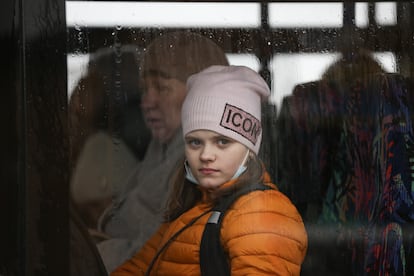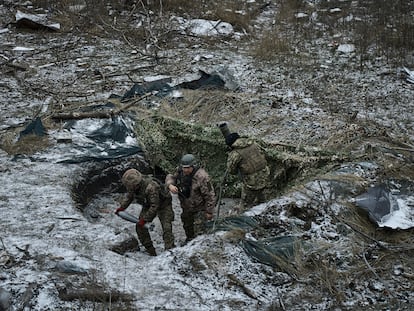Ukraine’s demographic drain puts its post-war recovery at risk
Millions of Ukrainian women and children have moved overseas and do not plan to return to a country that has lost over 30% of its population since independence in 1991


Trains crossing the Ukrainian border from countries in the European Union this December have been full of mothers returning to their home country for a few days, returning with their children to spend the Christmas vacation with their families. It won’t be long before they make the return journey again. “Of my Ukrainian acquaintances in Spain there is a group of about 25 of us who met each other in the host programs. We all have children and none of us wants to live in Ukraine. Zero”, said 35-year-old Alona Soroka last Thursday in Kyiv, where she is visiting her parents and husband. She now lives in Malgrat de Mar in Catalonia where she works as a hotel receptionist. Her goal is to stay in Spain permanently.
“There I have security, quality of life, good education for my two daughters [aged 4 and 10] and a job with which I can grow,” said Soroka. “To live well in Ukraine you need a lot of money because prices are sky-high and salaries are bad. Do you know how much my mother gets for her monthly pension? The equivalent of €30 ($32).” Her husband cannot leave Ukraine because under martial law men aged 18-60 who are deemed fit for combat are restricted from leaving the country, with exceptions, such as parents with more than three children. Soroka does not believe that her husband wants to live in Spain in the future, but she doesn’t care: she arrived in Catalonia in March 2022, a few days after the Russian invasion began, and for her it was an opportunity to start a better life.
There are 6.3 million refugees who, like Soroka, left Ukraine during the war and have not returned, according to the United Nations Refugee Agency (UNHCR). More than half are women and a third are minors. The number of returnees is 1.1 million (of the nearly eight million who left), according to estimates by the International Organization for Migration (IOM). According to a UNHCR survey last July, 18% of those displaced abroad wanted to return to Ukraine within the next three months and 62% when the necessary security and stability conditions are in place; the remaining 20% were inclined not to return.
“My dream would be for 50% to return, and if it was 60%, I would be the happiest person in Ukraine,” Ella Libanova, director of the Ptoukha Institute for Demography and Social Studies (IDSS), said last November at the 7th Ukrainian Women’s Congress. A few days earlier, speaking the main Ukrainian television news channel, Libanova was extremely pessimistic: “The situation will be very bad, much worse than anyone can imagine.” The IDSS director revealed population forecasts for the country in 2033: a range of between 26 and 35 million inhabitants, including the territories forcibly annexed by Russia. If the average of the range is about 30 million, this represents a 42% smaller population than Ukraine had in the year of its independence, 1991, when there were 52 million inhabitants.
The IDSS also provides current and territory-specific data. When the Russian invasion began, Ukraine had 44 million inhabitants. In 2023, the number stands at 36 million, including the territories occupied by Russia. If the data is limited to the regions of unoccupied Ukraine, the figure drops to 32 million, a 38% decrease from 1991.
Ukraine was already a country with high migration levels, like the rest of the states that left the communist bloc after the collapse of the Soviet Union. But while other Eastern European countries managed to turn the situation around through political and economic stability, in Ukraine the situation has worsened, according to researcher Marina Tvedorstup in a report published last July by the Vienna Institute for International Economic Studies (WIIW). Tvedorstup cited five problems that the war has exacerbated: a declining birth rate, falling life expectancy, greater migration, an aging population, and destruction of the labor market.
“Disastrous for reconstruction”
Average life expectancy for men in Ukraine has dropped from 66.4 years pre-war to 57.3 in 2023, according to the IDSS; for women, it fell from 76.4 to 70.9 years. This is not only because of the tens of thousands of soldiers and civilians killed or wounded, but also “a worsening with the invasion of the mental and physical state of Ukrainians,” the Warsaw-based Center for Eastern Studies (OSW) stated in a July report, which warned that for Ukraine, “the prospect is of a demographic catastrophe” because of “the negative tendency for future generations to procreate, in addition to economic uncertainty.” Tvedorstup noted that Ukraine faces “a big drop in the birth rate” because of the “long-term impact” of the migration of women during the war: “The more infrastructure is destroyed during the war, the more likely it is that refugees will remain permanently abroad, which would be disastrous for reconstruction.”
With an average of 1.2 births per woman, Ukraine was already one of the countries with the lowest fertility rate in Europe before the Russian invasion, according to a 2023 report by the Joint Research Center (JRC), an agency of the European Commission: “The very low fertility rate is explained by the prevalence of families having only one child after independence, a result of economic uncertainty, poor expectations, lack of social services and family policies, and conservative gender norms.” The birth rate has fallen dramatically since the invasion, according to the IDSS: in 2022 it was 0.9 children per woman and this year the institute expects it to fall to 0.7. The average in the European Union, according to European Commission statistics, is 1.5.
The demographic imbalance by gender is also slowing the birth rate in Ukraine: if in 2022 there were 86 men for every 100 women in Ukraine, in 2023, according to the IDSS, there are 110 men for every 100 women. The EU average is 100 men for every 104 women. In a study published last summer by the Wilson Center in the United States, Libanova warned that after the war, if the Ukrainian economy does not recover quickly, the exodus will be greater: “Ukrainian families that are now divided, with men in Ukraine and women and children abroad, may choose to reunify abroad, not inside the country. This means Ukraine may lose an additional 1–1.5 million young, educated men.”
“It bears emphasizing that Ukraine is losing to migration not only the general population but people of a relatively young, reproductive age, educated and with work qualifications, usually determined to succeed,” Libanova noted — people like Anna Temochko, who has been living in Barcelona with her two children since the beginning of the invasion. She is a computer scientist and works remotely for a Ukrainian company. She does not rule out returning in the future to her hometown, Lviv, in one of the safest regions in Ukraine but also one of the most saturated with displaced people from the frontline eastern provinces, an internal diaspora that results in, for example, a rise in housing prices.
“Prices in Lviv are not much lower than in Spain, but with clearly lower salaries,” says the 35-year-old. Temochko believes there are three factors that tip the balance in favor of a person like her settling abroad: if she achieves economic stability, if she creates a new family, and if the children adapt well to the host society. She also admits to harboring a certain “feeling of injustice: injustice at being in Barcelona, in such a nice city, while there are more patriotic people than me in Ukraine”.
Temochko will travel to Lviv for Christmas. Her last visit was in August, during her children’s school vacations. In the summer she witnessed another reason why she is not planning to return: “If the economic situation worsens, societies become depressed. When I was there, I had the feeling of being in a tired and anxiety-ridden society. I don’t know if I want my children to grow up in such an environment.” As the war drags on, despondency is growing among the Ukrainian population. And the longer the conflict lasts, Libanova noted in her work for the Wilson Center, the harder it will be for the women who left to return.
Sign up for our weekly newsletter to get more English-language news coverage from EL PAÍS USA Edition
Tu suscripción se está usando en otro dispositivo
¿Quieres añadir otro usuario a tu suscripción?
Si continúas leyendo en este dispositivo, no se podrá leer en el otro.
FlechaTu suscripción se está usando en otro dispositivo y solo puedes acceder a EL PAÍS desde un dispositivo a la vez.
Si quieres compartir tu cuenta, cambia tu suscripción a la modalidad Premium, así podrás añadir otro usuario. Cada uno accederá con su propia cuenta de email, lo que os permitirá personalizar vuestra experiencia en EL PAÍS.
¿Tienes una suscripción de empresa? Accede aquí para contratar más cuentas.
En el caso de no saber quién está usando tu cuenta, te recomendamos cambiar tu contraseña aquí.
Si decides continuar compartiendo tu cuenta, este mensaje se mostrará en tu dispositivo y en el de la otra persona que está usando tu cuenta de forma indefinida, afectando a tu experiencia de lectura. Puedes consultar aquí los términos y condiciones de la suscripción digital.
More information
Archived In
Últimas noticias
The secrets of the Washingtonia palm, named after the first US president
The struggle for hegemony: US and China compete for supremacy in a turbulent landscape
Gary Stevenson: ‘The left has a problem when it comes to how it perceives young men’
Meg O’Neill, the woman who made history in the petroleum industry
Most viewed
- David King, chemist: ‘There are scientists studying how to cool the planet; nobody should stop these experiments from happening’
- Mexico completes its trade shift with the entry into force of tariffs on China and countries without trade agreements
- Reinhard Genzel, Nobel laureate in physics: ‘One-minute videos will never give you the truth’
- Oona Chaplin: ‘I told James Cameron that I was living in a treehouse and starting a permaculture project with a friend’
- Sinaloa Cartel war is taking its toll on Los Chapitos










































